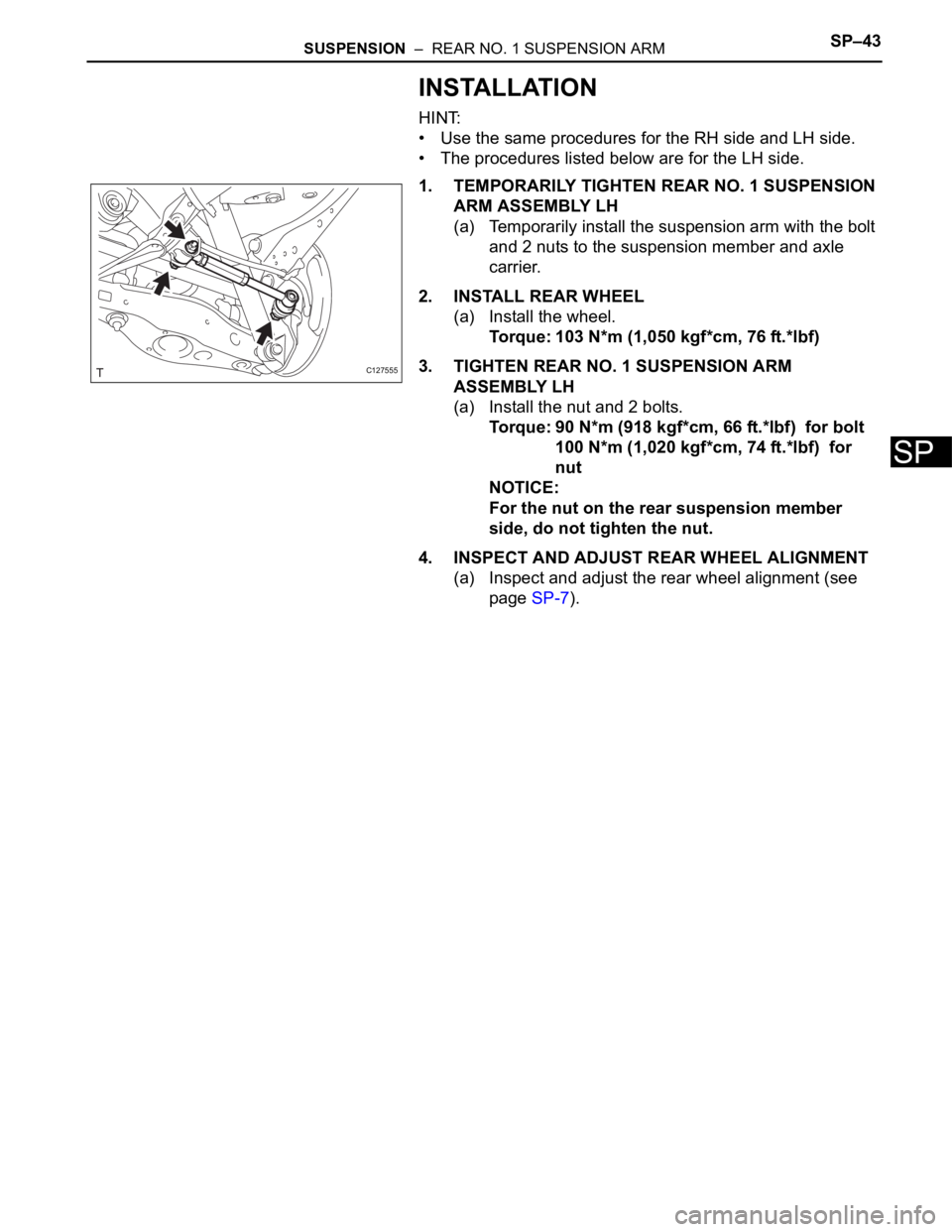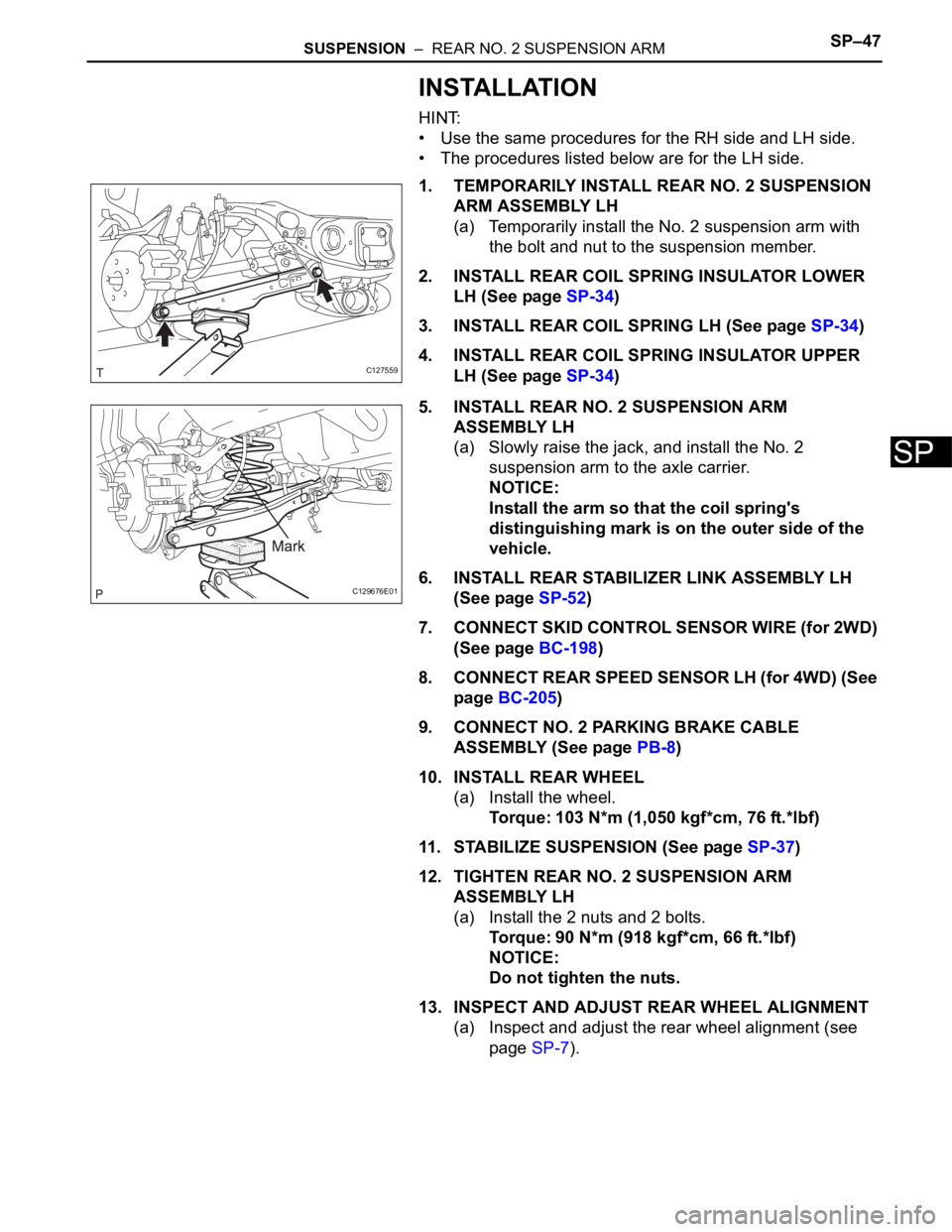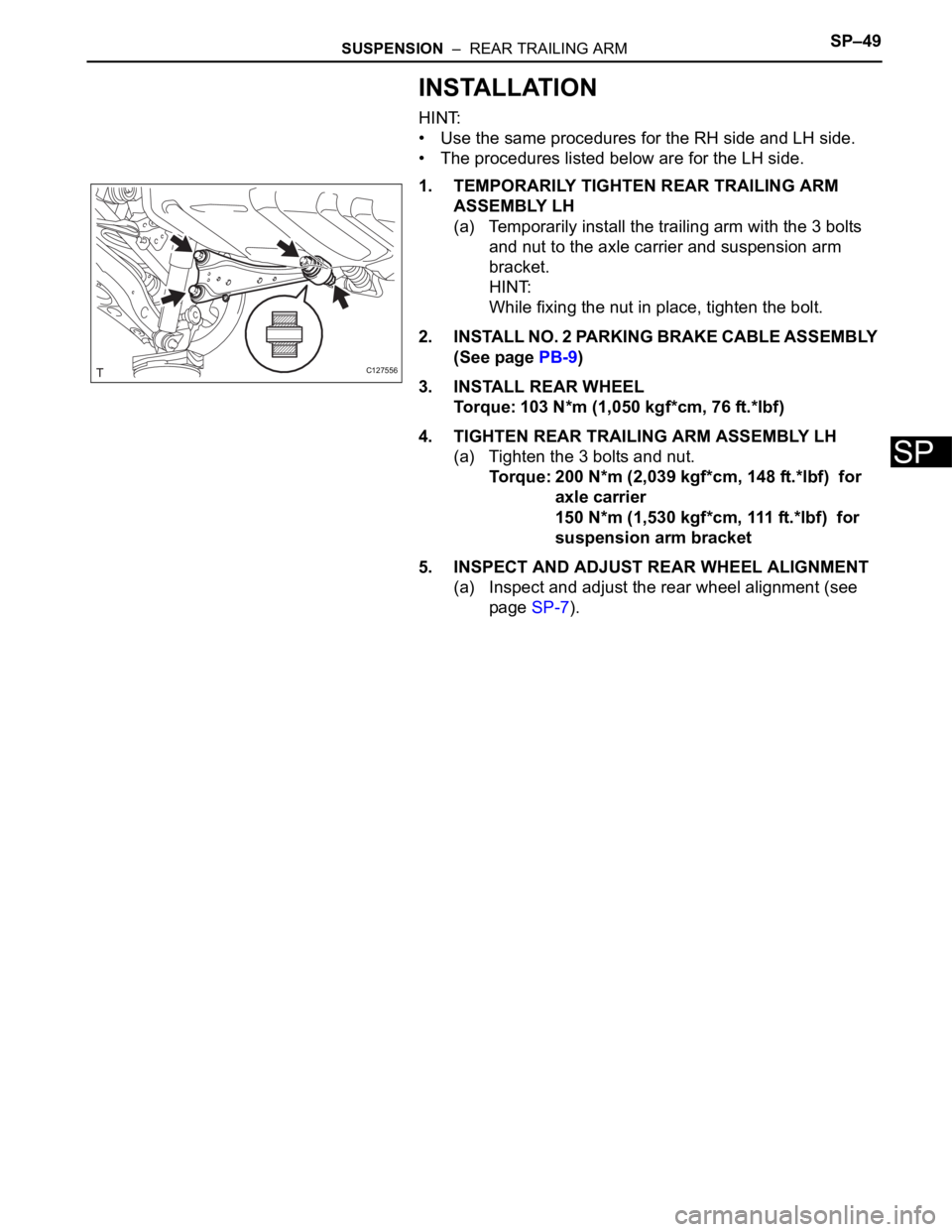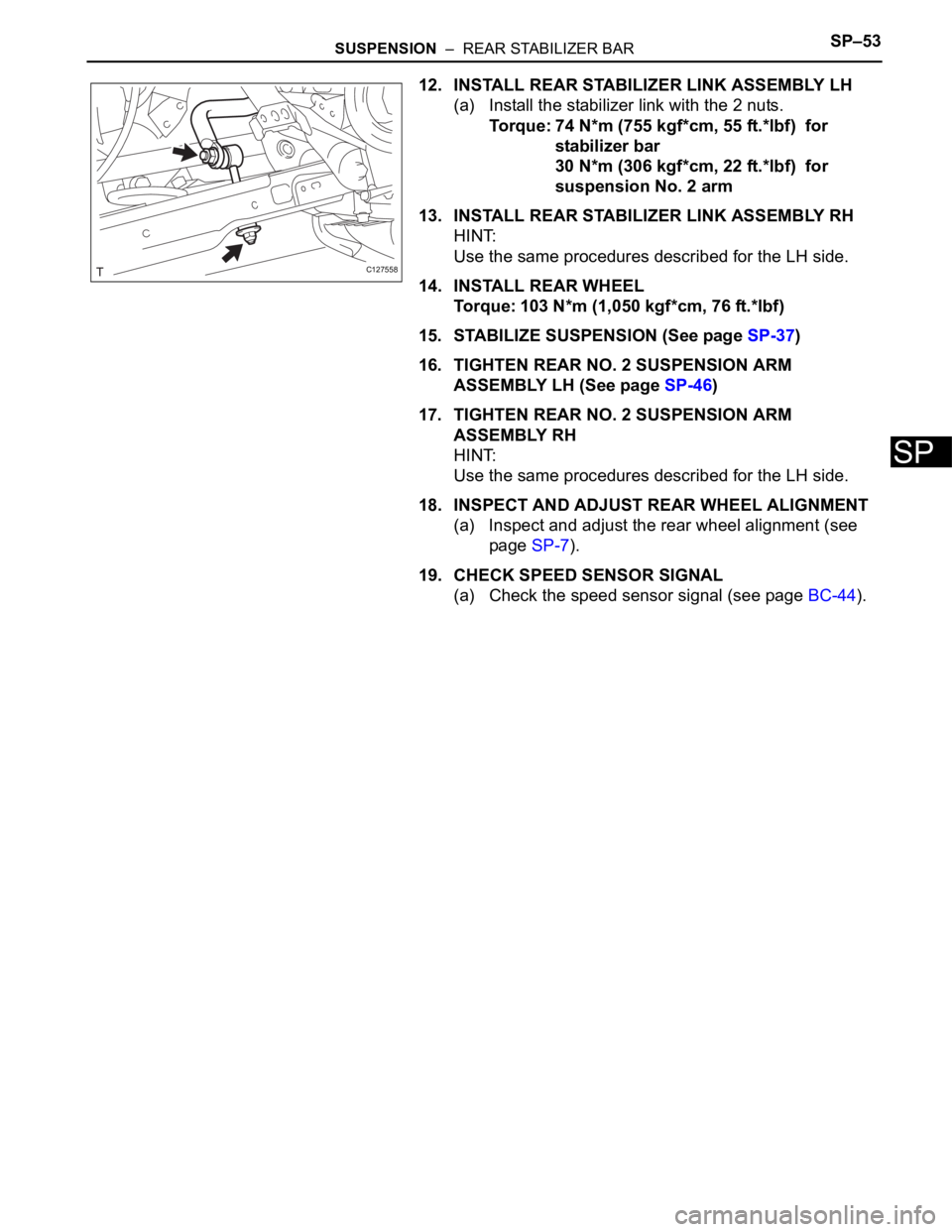2006 TOYOTA RAV4 wheel torque
[x] Cancel search: wheel torquePage 1472 of 2000

SUSPENSION – REAR NO. 1 SUSPENSION ARMSP–43
SP
INSTALLATION
HINT:
• Use the same procedures for the RH side and LH side.
• The procedures listed below are for the LH side.
1. TEMPORARILY TIGHTEN REAR NO. 1 SUSPENSION
ARM ASSEMBLY LH
(a) Temporarily install the suspension arm with the bolt
and 2 nuts to the suspension member and axle
carrier.
2. INSTALL REAR WHEEL
(a) Install the wheel.
Torque: 103 N*m (1,050 kgf*cm, 76 ft.*lbf)
3. TIGHTEN REAR NO. 1 SUSPENSION ARM
ASSEMBLY LH
(a) Install the nut and 2 bolts.
Torque: 90 N*m (918 kgf*cm, 66 ft.*lbf) for bolt
100 N*m (1,020 kgf*cm, 74 ft.*lbf) for
nut
NOTICE:
For the nut on the rear suspension member
side, do not tighten the nut.
4. INSPECT AND ADJUST REAR WHEEL ALIGNMENT
(a) Inspect and adjust the rear wheel alignment (see
page SP-7).
C127555
Page 1473 of 2000

SUSPENSION – REAR NO. 2 SUSPENSION ARMSP–47
SP
INSTALLATION
HINT:
• Use the same procedures for the RH side and LH side.
• The procedures listed below are for the LH side.
1. TEMPORARILY INSTALL REAR NO. 2 SUSPENSION
ARM ASSEMBLY LH
(a) Temporarily install the No. 2 suspension arm with
the bolt and nut to the suspension member.
2. INSTALL REAR COIL SPRING INSULATOR LOWER
LH (See page SP-34)
3. INSTALL REAR COIL SPRING LH (See page SP-34)
4. INSTALL REAR COIL SPRING INSULATOR UPPER
LH (See page SP-34)
5. INSTALL REAR NO. 2 SUSPENSION ARM
ASSEMBLY LH
(a) Slowly raise the jack, and install the No. 2
suspension arm to the axle carrier.
NOTICE:
Install the arm so that the coil spring's
distinguishing mark is on the outer side of the
vehicle.
6. INSTALL REAR STABILIZER LINK ASSEMBLY LH
(See page SP-52)
7. CONNECT SKID CONTROL SENSOR WIRE (for 2WD)
(See page BC-198)
8. CONNECT REAR SPEED SENSOR LH (for 4WD) (See
page BC-205)
9. CONNECT NO. 2 PARKING BRAKE CABLE
ASSEMBLY (See page PB-8)
10. INSTALL REAR WHEEL
(a) Install the wheel.
Torque: 103 N*m (1,050 kgf*cm, 76 ft.*lbf)
11. STABILIZE SUSPENSION (See page SP-37)
12. TIGHTEN REAR NO. 2 SUSPENSION ARM
ASSEMBLY LH
(a) Install the 2 nuts and 2 bolts.
Torque: 90 N*m (918 kgf*cm, 66 ft.*lbf)
NOTICE:
Do not tighten the nuts.
13. INSPECT AND ADJUST REAR WHEEL ALIGNMENT
(a) Inspect and adjust the rear wheel alignment (see
page SP-7).
C127559
C129676E01
Page 1474 of 2000

SUSPENSION – REAR TRAILING ARMSP–49
SP
INSTALLATION
HINT:
• Use the same procedures for the RH side and LH side.
• The procedures listed below are for the LH side.
1. TEMPORARILY TIGHTEN REAR TRAILING ARM
ASSEMBLY LH
(a) Temporarily install the trailing arm with the 3 bolts
and nut to the axle carrier and suspension arm
bracket.
HINT:
While fixing the nut in place, tighten the bolt.
2. INSTALL NO. 2 PARKING BRAKE CABLE ASSEMBLY
(See page PB-9)
3. INSTALL REAR WHEEL
Torque: 103 N*m (1,050 kgf*cm, 76 ft.*lbf)
4. TIGHTEN REAR TRAILING ARM ASSEMBLY LH
(a) Tighten the 3 bolts and nut.
Torque: 200 N*m (2,039 kgf*cm, 148 ft.*lbf) for
axle carrier
150 N*m (1,530 kgf*cm, 111 ft.*lbf) for
suspension arm bracket
5. INSPECT AND ADJUST REAR WHEEL ALIGNMENT
(a) Inspect and adjust the rear wheel alignment (see
page SP-7).
C127556
Page 1477 of 2000

SUSPENSION – REAR STABILIZER BARSP–53
SP
12. INSTALL REAR STABILIZER LINK ASSEMBLY LH
(a) Install the stabilizer link with the 2 nuts.
Torque: 74 N*m (755 kgf*cm, 55 ft.*lbf) for
stabilizer bar
30 N*m (306 kgf*cm, 22 ft.*lbf) for
suspension No. 2 arm
13. INSTALL REAR STABILIZER LINK ASSEMBLY RH
HINT:
Use the same procedures described for the LH side.
14. INSTALL REAR WHEEL
Torque: 103 N*m (1,050 kgf*cm, 76 ft.*lbf)
15. STABILIZE SUSPENSION (See page SP-37)
16. TIGHTEN REAR NO. 2 SUSPENSION ARM
ASSEMBLY LH (See page SP-46)
17. TIGHTEN REAR NO. 2 SUSPENSION ARM
ASSEMBLY RH
HINT:
Use the same procedures described for the LH side.
18. INSPECT AND ADJUST REAR WHEEL ALIGNMENT
(a) Inspect and adjust the rear wheel alignment (see
page SP-7).
19. CHECK SPEED SENSOR SIGNAL
(a) Check the speed sensor signal (see page BC-44).
C127558
Page 1515 of 2000

BC–12BRAKE CONTROL – VEHICLE STABILITY CONTROL SYSTEM
BC
(1) Operation description:
The skid control ECU determines the vehicle
condition by receiving signals from the speed
sensor, the yaw rate and deceleration sensor
and the steering sensor. The skid control ECU
controls engine torque with the ECM via CAN
communication and brake fluid pressure through
the pump and solenoid valve. The slip indicator
light blinks and the skid control buzzer sounds
when the system is operating.
for 4WD: The VSC warning light comes on when
the TRC system malfunctions.
for 2WD: The VSC warning light and slip
indicator light come on when the TRC system
malfunctions.
(f) Downhill Assist Control:
When the downhill assist control switch is pressed
with the shift lever on L or R range and the
accelerator and brake pedals not depressed,
downhill assist control is activated. When activated,
4-wheel hydraulic pressure control occurs in order
to maintain a constant low vehicle speed without
causing the wheels to become locked. Thus, the
vehicle can descend a steep hill in a stable manner.
HINT:
• Depressing the accelerator and brake pedal
cancels control of the downhill assist control.
• Downhill assist control begins operating when
driving down on a slope at a speed of 25 km/h
(16 mph) or less with the engine brake applied.
Page 1518 of 2000

BRAKE CONTROL – VEHICLE STABILITY CONTROL SYSTEMBC–15
BC
(1) Operation description:
When the system is in operation, the following
occurs: 1) the slip indicator light blinks; 2) the
VSC light comes on; and 3) when hill-start assist
control operation starts, the skid control buzzer
sounds once; when hill-start assist control
operation ends, the skid control buzzer sounds
twice.
The VSC warning light comes on when the hill-
start assist control is malfunctioning.
(h) AUTO LSD (Auto Limited Slip Differential) for 2WD:
The AUTO LSD achieves the equivalent functions of
an LSD (Limited Slip Differential) through the use of
a traction control system. When the driver presses
the AUTO LSD switch, this system achieves the
LSD effect by regulating the hydraulic pressure that
acts on the drive wheels and controlling the engine
output in accordance with the amount of pedal effort
applied on the accelerator. The AUTO LSD
operates with the AUTO LSD switch on and the
accelerator pedal depressed.
Auto LSD restrains brake pressure and reduces
differential movement, thus transmitting the drive
torque to the other drive wheel to ensure stability
under the following conditions:
• Wheels run off the road.
• Drive wheels spin in place when starting on a
slope with one wheel on snow/ice.
HINT:
Releasing the accelerator pedal cancels control of
the AUTO LSD system.
Page 1520 of 2000

BRAKE CONTROL – VEHICLE STABILITY CONTROL SYSTEMBC–17
BC
(1) Operation description:
The skid control ECU determines that the
vehicle is in a state in which the AUTO LSD can
operate by using various sensors and switches
to detect the operating conditions of the AUTO
LSD switch, shift position, accelerator pedal, and
brake pedal. When the vehicle is in a state in
which the AUTO LSD can operate, the skid
control ECU effects hydraulic pressure control of
the wheel cylinder at the wheel with the faster
wheel speed so that the wheel speeds of the
right and left drive wheels will become equal.
The slip indicator light blinks and the AUTO LSD
indicator light comes on when the system is
operating. Both the VSC warning light and SLIP
indicator light come on when the AUTO LSD
system malfunctions.
2. COOPERATIVE CONTROL FUNCTION
(a) Description
(1) Braking when Surface Resistance Differs
Between Left and Right Wheels
If the driver suddenly applies the brakes on a
road surface with a considerable difference in
friction coefficient between the right and left
wheels, the difference in the brake force
between the right and left wheels will cause the
vehicle posture to become unstable and create a
yaw movement. In this state, the skid control
ECU controls the VSC to stabilize the vehicle
posture. At the same time, it effects cooperative
control with the EPS to provide steering torque
assist, which facilitates the driver's steering
maneuvers to stabilize the vehicle posture.
(2) Accelerating when Surface Resistance Differs
Between Left and Right Wheels
If the driver suddenly starts off or accelerates on
a road surface with a considerable difference in
friction coefficient between the right and left
wheels, the slippage of a drive wheel will cause
the vehicle posture to become unstable and
negatively affect its acceleration performance. In
this state, the skid control ECU causes the TRC
to control the hydraulic brake of the slipping
drive wheel, and requests the engine ECU to
effect engine output control. At the same time, it
effects cooperative control with the EPS to
provide steering torque assist, which facilitates
the driver's steering maneuvers to stabilize the
vehicle posture.
Page 1521 of 2000

BC–18BRAKE CONTROL – VEHICLE STABILITY CONTROL SYSTEM
BC
(3) Front Wheel Skid Tendency
When the skid control ECU determines that
there is a front wheel skid tendency, it controls
the VSC to dampen the front wheel skid. At the
same time, it effects cooperative control with the
EPS to provide steering torque assist, which
facilitates the driver's steering maneuvers to
stabilize the vehicle posture. To prevent
excessive steering maneuvers, it provides a
steering torque assist. This assist increases the
resistance to counter the driver's steering effort,
if the driver turns the steering wheel excessively.
(4) Rear Wheel Skid Tendency
When the skid control ECU determines that
there is a rear wheel skid tendency, it controls
the VSC to dampen the rear wheel skid. At the
same time, it effects cooperative control with the
EPS to provide steering torque assist, which
facilitates the driver's steering maneuvers in the
direction to correct the rear wheel skid.
(5) Acceleration During Cornering
A sudden acceleration of the vehicle during
cornering may cause a drive wheel to freewheel,
which could cause the front wheels or rear
wheels to skid. If the skid control ECU
determines that there is freewheeling of a drive
wheel, a front wheel skid tendency, or a rear
wheel skid tendency, it effects cooperative
control with the 4WD system to optimally control
the drive torque distribution to the front and rear
wheels. Furthermore, it controls the TRC and
the VSC as needed to ensure driving stability
and acceleration performance.
(b) Operation
The operation of the solenoid valves under the
cooperative control is the same as the TRC or VSC
operation.
3. ABS WITH EBD, BA, TRC AND VSC OPERATION
(a) The skid control ECU calculates vehicle stability
tendency based on the signals from the 4 wheel
speed sensors, the yaw rate and deceleration
sensor and the steering sensor. In addition, it
evaluates the results of the calculations to
determine whether any control actions (control of
the engine output torque by electronic throttle
control and of the brake fluid pressure by the ABS
and TRACTION actuator) should be implemented.
(b) The slip indicator blinks and the skid control buzzer
sounds to inform the driver that the VSC system is
operating. The slip indicator also blinks when
traction control is operating, and the operation being
performed is displayed.